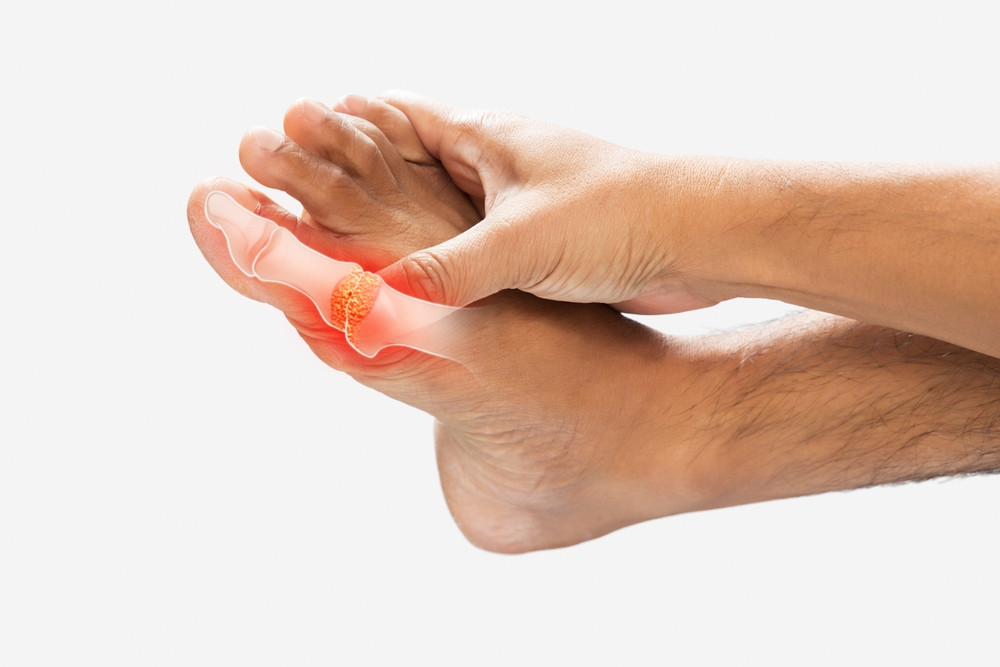Gout is a form of inflammatory arthritis characterised by sudden, severe episodes of joint pain – often in the big toe, but it can affect other joints as well. These painful flare-ups occur when high levels of uric acid accumulate in the bloodstream and form crystals in the joints. While genetics can play a role, lifestyle factors significantly influence how often and how intensely gout attacks strike.
Below, we’ll explore practical tips on how to avoid painful flare-ups by modifying your diet, maintaining a healthy lifestyle, and following specialist recommendations for long-term joint health.
1. Learn About the Role of Purine-Rich Foods
Why Purines Matter
Purines are natural compounds found in certain foods. When your body breaks down purines, it produces uric acid. Consuming too many purine-rich foods can raise uric acid levels, triggering gout flare-ups.
Foods to Limit or Avoid
- Red Meat and Organ Meats – Beef, pork, lamb, liver, and kidney are high in purines.
- Seafood – Certain fish (like anchovies, sardines, and trout) and shellfish (like shrimp and scallops) can increase uric acid levels.
- Alcoholic Beverages – Beer and spirits in particular can be problematic; they raise uric acid and reduce its excretion.
Healthier Alternatives
Opt for lean proteins like chicken, turkey, and fish lower in purines (e.g., salmon). Incorporate plenty of vegetables, fruits, and whole grains to keep your diet balanced and to manage your overall health effectively.
2. Stay Hydrated
Role of Adequate Water Intake
Drinking enough water helps dilute uric acid in the bloodstream and supports its removal through the kidneys. Proper hydration can significantly reduce the frequency and intensity of gout attacks.
Tips to Boost Hydration
- Set Hydration Goals – Aim for at least 8–10 cups of fluid daily, adjusting for activity levels and climate.
- Infuse Your Water – Add lemon slices or cucumber for a refreshing twist if plain water feels bland.
- Limit Sugary Beverages – Sodas and fruit juices high in fructose can elevate uric acid levels, so choose water and unsweetened options instead.
3. Maintain a Healthy Weight
Why Weight Matters for Gout
Excess body weight increases insulin resistance and overall inflammation, worsening gout symptoms. Losing weight (if needed) often helps control uric acid levels and reduces joint stress.
Sustainable Weight Management
- Balanced Diet – Focus on whole foods—fruits, vegetables, whole grains, and lean proteins.
- Portion Control – Being mindful of serving sizes can prevent overconsumption of purine-rich or high-calorie foods.
- Gradual Changes – Aim for a slow and steady weight loss of 1–2 pounds per week, which is safer and more sustainable in the long run.
4. Incorporate Regular Exercise
Benefits for Gout Sufferers
Physical activity can improve circulation, lower inflammation, and aid in maintaining a healthy weight. Joint pain specialists often recommend low-impact exercises that don’t stress the joints excessively.
Recommended Exercises
- Walking or Swimming – Low-impact activities that improve cardiovascular health without putting undue pressure on your joints.
- Cycling – Another great option that’s easier on the knees and ankles.
- Gentle Stretching and Yoga – Helps increase flexibility and range of motion, potentially easing joint discomfort.
Exercise Safely
- Start Slowly – Gradually build up the duration and intensity of your workouts.
- Stay Hydrated – Drink water before, during, and after exercise.
- Listen to Your Body – Avoid pushing through severe pain. Talk to a specialist if you experience persistent discomfort.
5. Follow Specialist Recommendations
Medication Management
Your rheumatologist or joint pain specialist may prescribe medications to control uric acid levels or manage flare-ups. Common options include:
- Xanthine Oxidase Inhibitors (e.g., allopurinol, febuxostat) to reduce uric acid production.
- Uricosuric Agents (e.g., probenecid) to help the body eliminate uric acid more efficiently.
- NSAIDs or Corticosteroids to relieve acute pain during flare-ups.
Regular Check-Ups
Frequent monitoring of uric acid levels and joint health allows your specialist to make timely adjustments to your treatment plan. Be transparent about any new symptoms, side effects, or lifestyle changes that could impact your gout management.
Personalised Guidance
A specialist will tailor recommendations based on your medical history, risk factors, and overall health. Combining medical therapies with healthy lifestyle choices maximises your chances of avoiding or minimising painful flare-ups.
Preventing gout attacks hinges on a few key strategies – limiting purine-rich foods, staying well-hydrated, maintaining a healthy weight, exercising wisely, and following your specialist’s advice. By incorporating these practical tips into your daily routine, you can significantly reduce the frequency and severity of gout flare-ups, ultimately improving your long-term joint health and quality of life.
Ready to Take Control of Your Gout? Contact AARIA Rheumatology
If you’re looking for personalised guidance on preventing gout attacks and achieving optimal joint health, AARIA Rheumatology is here to help. Led by Dr. Anindita Santosa, our experienced team offers comprehensive evaluations, tailored treatment plans, and advice on diet and lifestyle choices.
Reach out to AARIA Rheumatology today to schedule a consultation. Together, we’ll help you create an effective management plan so you can live a pain-free, active life -even with gout.






